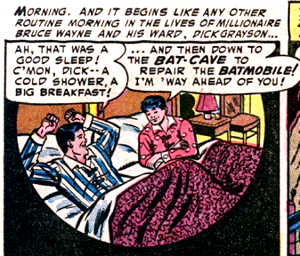Homosexuality in the Batman franchise
== Homosexuality in the Batman Franchise ==
Homosexuality in the Batman franchise has been a subject of discussion and analysis for many years. The portrayal of characters and the subtext within the stories have led to various interpretations and debates among fans, scholars, and critics.
Historical Context[edit | edit source]
The Batman franchise, created by Bob Kane and Bill Finger, debuted in Detective Comics #27 in 1939. Over the decades, the franchise has evolved, encompassing comic books, television series, films, and other media. The interpretation of characters' sexual orientations has varied, influenced by societal attitudes and the creative visions of different writers and artists.
Batman and Robin[edit | edit source]
One of the most discussed aspects of homosexuality in the Batman franchise is the relationship between Batman (Bruce Wayne) and his sidekick Robin (Dick Grayson). The close partnership and living arrangements of the two characters have led to speculation about a possible homosexual subtext. This interpretation was notably popularized by psychiatrist Fredric Wertham in his 1954 book, "Seduction of the Innocent," where he argued that Batman and Robin's relationship was implicitly homosexual.
Villains and Allies[edit | edit source]
Several villains and allies in the Batman franchise have also been interpreted as having homosexual subtext or have been explicitly portrayed as LGBTQ+ characters. For example, the character Harley Quinn has been depicted in a romantic relationship with Poison Ivy in various comic book series. Additionally, the character Renee Montoya, a Gotham City police officer, is openly lesbian in the comics.
Modern Interpretations[edit | edit source]
In recent years, the Batman franchise has become more inclusive, with explicit representation of LGBTQ+ characters. The character Batwoman (Kate Kane), introduced in 2006, is an openly lesbian superhero and has been a prominent figure in the franchise. The inclusion of such characters reflects broader changes in society and the comic book industry’s efforts to embrace diversity.
Cultural Impact[edit | edit source]
The discussion of homosexuality in the Batman franchise has had a significant cultural impact, influencing both the perception of the characters and the broader discourse on LGBTQ+ representation in media. The franchise's handling of these themes continues to evolve, reflecting ongoing changes in societal attitudes towards sexuality and representation.
Related Pages[edit | edit source]
- Batman
- Robin (character)
- Harley Quinn
- Poison Ivy (character)
- Batwoman
- Renee Montoya
- LGBTQ+ representation in comics
| Batman | ||||
|---|---|---|---|---|
* Category
|
Transform your life with W8MD's budget GLP1 injections from $125
W8MD offers a medical weight loss program NYC and a clinic to lose weight in Philadelphia. Our W8MD's physician supervised medical weight loss centers in NYC provides expert medical guidance, and offers telemedicine options for convenience.
Why choose W8MD?
- Comprehensive care with FDA-approved weight loss medications including:
- loss injections in NYC both generic and brand names:
- weight loss medications including Phentermine, Qsymia, Diethylpropion etc.
- Accept most insurances for visits or discounted self pay cost.
- Generic weight loss injections starting from just $125.00 for the starting dose
- In person weight loss NYC and telemedicine medical weight loss options in New York city available
- Budget GLP1 weight loss injections in NYC starting from $125.00 biweekly with insurance!
Book Your Appointment
Start your NYC weight loss journey today at our NYC medical weight loss, and Philadelphia medical weight loss Call (718)946-5500 for NY and 215 676 2334 for PA
Search WikiMD
Ad.Tired of being Overweight? Try W8MD's NYC physician weight loss.
Semaglutide (Ozempic / Wegovy and Tirzepatide (Mounjaro / Zepbound) available. Call 718 946 5500.
Advertise on WikiMD
|
WikiMD's Wellness Encyclopedia |
| Let Food Be Thy Medicine Medicine Thy Food - Hippocrates |
Translate this page: - East Asian
中文,
日本,
한국어,
South Asian
हिन्दी,
தமிழ்,
తెలుగు,
Urdu,
ಕನ್ನಡ,
Southeast Asian
Indonesian,
Vietnamese,
Thai,
မြန်မာဘာသာ,
বাংলা
European
español,
Deutsch,
français,
Greek,
português do Brasil,
polski,
română,
русский,
Nederlands,
norsk,
svenska,
suomi,
Italian
Middle Eastern & African
عربى,
Turkish,
Persian,
Hebrew,
Afrikaans,
isiZulu,
Kiswahili,
Other
Bulgarian,
Hungarian,
Czech,
Swedish,
മലയാളം,
मराठी,
ਪੰਜਾਬੀ,
ગુજરાતી,
Portuguese,
Ukrainian
Medical Disclaimer: WikiMD is not a substitute for professional medical advice. The information on WikiMD is provided as an information resource only, may be incorrect, outdated or misleading, and is not to be used or relied on for any diagnostic or treatment purposes. Please consult your health care provider before making any healthcare decisions or for guidance about a specific medical condition. WikiMD expressly disclaims responsibility, and shall have no liability, for any damages, loss, injury, or liability whatsoever suffered as a result of your reliance on the information contained in this site. By visiting this site you agree to the foregoing terms and conditions, which may from time to time be changed or supplemented by WikiMD. If you do not agree to the foregoing terms and conditions, you should not enter or use this site. See full disclaimer.
Credits:Most images are courtesy of Wikimedia commons, and templates, categories Wikipedia, licensed under CC BY SA or similar.
Contributors: Prab R. Tumpati, MD



